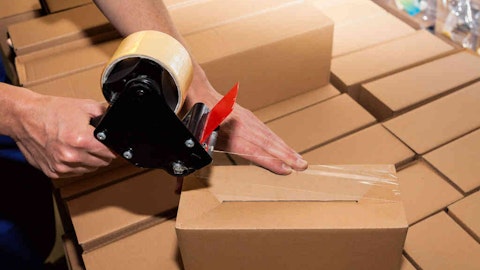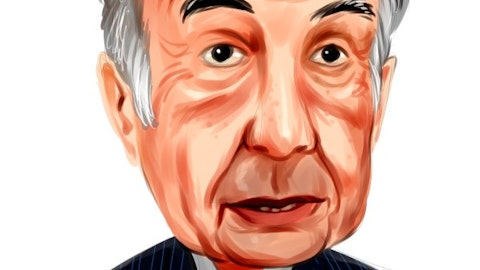Crown Holdings, Inc. (NYSE:CCK) Q3 2023 Earnings Call Transcript October 24, 2023
Operator: Good morning, and welcome to Crown Holdings Third Quarter 2023 Conference Call. Your lines have been placed on a listen-only mode until the question-and-answer session. Please be advised that this conference is being recorded. I would now like to turn the call over to you, Mr. Kevin Clothier, Senior Vice President and Chief Financial Officer. Sir, you may begin.
Kevin Clothier: Thank you, Elmer, and good morning. With me on today’s call is Tim Donahue, President and Chief Executive Officer. If you do not already have the earnings release, it is available on our website at crowncork.com. On this call, as in the earnings release, we will be making a number of forward-looking statements. Actual results could vary materially from such statements. Additional information concerning factors that could cause actual results to vary are contained in the press release and in our SEC filings, including our Form 10-K for 2022 and subsequent filings. Third quarter earnings were $1.33 a share compared to $1.06 in the prior third quarter. Adjusted earnings per share were $1.73 per share in the quarter compared to $1.46 in 2022.
Net sales in the quarter were down 6% from prior year, as higher sales unit volumes in Americas Beverage and $60 million positive impact from foreign currency translation were offset by the pass through of $187 million of lower raw material costs and lower unit volumes in most other businesses. Segment income at $430 million in the quarter compared to $336 million in the prior year and reflects the benefit of higher unit volumes in North America, the contractual recovery of prior year’s inflationary cost increases in European beverage, and the cost reduction initiatives in Transit Packaging. Cash flow of $832 million for the first nine months of ’23 compared to $134 million in the prior year, the result of better working capital management.
Net leverage improved to 3.5 times, a half turn improvement from the second quarter, driven by higher third quarter operating income and better operating cash flow. Fourth quarter adjusted EPS is projected to be in the range of $1.40 to $1.50 per share with a full year adjusted EPS of $6 to $6.10 per share. Our guidance includes the following. Net interest expense of approximately $390 million, a $0.40 incremental non-cash pension and post-retirement costs, average common shares outstanding of approximately 120 million and full year tax rate of approximately 24%, depreciation of approximately $340 million compared to $301 million in ’22, non-controlling interest expense to be approximately $135 million, dividends and non-controlling interests, approximately $120 million.
After capital spending of $900 million, free cash flow is projected at $500 million, and we currently expect year-end leverage to be 3.25 times. With that, I’ll turn the call over to Tim.

A closeup shot of a large industrial machine that manufactures steel cans.
Timothy Donahue: Thank you, Kevin, and good morning to everyone. Kevin just provided a sea of numbers, so I’ll be brief, and then we’ll open the call for questions. As reflected in last night’s earnings release and as Kevin just summarized, third quarter performance was in line with expectations as each of our three larger businesses, that is Americas Beverage, European Beverage and Transit Packaging all continued to perform well, offsetting softness in North American aerosols in Asia. For the quarter, total company segment income improved by 28% from a challenging prior year third quarter and we expect similar improvement in the fourth quarter. Importantly, through nine months, and as Kevin just noted, free cash is $700 million ahead of the prior year nine-month period due to an improved working capital position with net leverage being reduced by a full one-half turn in the quarter.
As Kevin noted, we estimate year-end net leverage to be around 3.25 times after giving effect to the Helvetia Packaging acquisition completed in early October. North American volumes advanced 12.6% in the third quarter, helping to advance income in the Americas Beverage segment by 25% over the prior year. Through nine months, unit volumes in North America are up more than 6% over the prior year. And while we are still early in the fourth quarter, demand remains firm and we maintain our estimate of 7% growth for the full year. Earlier this month, commercial shipments commenced from line one at the company’s new plant in Mesquite, Nevada, with the startup of line two scheduled before the end of the year. Post-pandemic economic conditions appear to be improving in Brazil, and we remain positive as we enter the busy summer selling season.
Income performance in European Beverage was up significantly over the prior year as inflationary pass throughs helped the business recover margin from the challenging prior year third quarter. Our unit volumes in the quarter were down 5% across the segment as our regional mix, which is weighted more towards Southern Europe, so our volumes underperform a flattish market. More important than volumes, acceptable operating margins have been restored to the business. Unit volumes across Asia Pacific were down 9%, with continued weakness in Vietnam as fillers across that country look to adjust their filled goods inventory into weakening economic conditions. Volumes across Cambodia and China remained firm in the quarter. Income in Transit Packaging was up almost 20% in the quarter, as continued positive price/cost management, combined with reduced overhead costs and higher equipment deliveries more than offset lower consumables volumes.
A solid performance through nine months with income at 15% of net sales and tracking for another very strong full year cash flow performance. With a more streamlined cost structure, the business is well positioned to benefit further as industrial activity improves in the future. Performance across North American tinplate and can making equipment continued to be impacted by a very soft aerosol can demand with aerosol volumes in the quarter of 15% to the prior year. So in summary, and as we said earlier, third quarter performance was on plan, income up, leverage down, and our expectation is that fourth quarter EBITDA should improve by a similar percentage as the third quarter, delivering further debt and leverage reduction. And before we open the call to questions, we again would ask that you limit yourselves to two questions, so that as many of you as possible will have an opportunity.
And with that, Elmer, we are now ready to take questions, please.
See also 12 Best Places to Retire in Austria and 10 Leading Social Media Companies In The Artificial Intelligence Theme.
Q&A Session
Follow Crown Holdings Inc. (NYSE:CCK)
Follow Crown Holdings Inc. (NYSE:CCK)
Operator: Thank you, speakers. We’ll now begin our question-and-answer session. [Operator Instructions] And our first question is from the line of Mr. Mike Leithead from Barclays. Your line is open. You may begin.
Mike Leithead: Great. Thanks. Good morning, guys.
Timothy Donahue: Good morning, Mike.
Mike Leithead: I know the world is a bit uncertain right now but can you maybe speak to any early thoughts about Crown’s 2024 earnings potential or company-specific drivers?
Timothy Donahue: Why don’t we leave that till February. I think we’re — I wouldn’t say we’re early in the budget process, but we’re not yet complete. Still some things moving around. And I think that will be better served if we wait until we complete the process.
Mike Leithead: Fair enough. And then secondly, just on North America, you’ve sort of reaffirmed kind of your outlook for volumes for the full year. Can you speak to — obviously, you have your own company-specific tailwinds, but just what your conversations with your customers are, demand, etc., just in the North America market today?
Timothy Donahue: Yes. So our mix, perhaps a little different than some of the others, but weighted more towards CSD, nutraceuticals, light energy drinks, carbonated water. Our customers continue to push cans. They see cans as an important element in their sustainability journey. And we’re going to continue to benefit as long as they can continue to promote the can. So as we sit here today, I would say a very positive on the volume outlook for Q4. And obviously, we’ve got a higher base, but the absolute number of can growth that we see in ’24, probably similar to the absolute level of can growth we saw in ’23. So significant can growth again.
Mike Leithead: Great. Thank you.
Timothy Donahue: You’re welcome.
Operator: Thank you. Next question is from the line of George Staphos from Bank of America. Your line is open. You may begin.
Cashen Keeler: Yes. Hi, good morning. This is actually Cashen Keeler on for George. We had conflicting calls this morning. So, I guess, just first on the revised guidance, I guess what segments saw the biggest change in your forecast relative to prior expectations? Was that primarily Asia and aerosol? And I guess is it possible to put any numbers around changes in expectations there?
Timothy Donahue: Yes. I think it’s — as we said in the release, last night’s release, and as both Kevin and I said in the prepared comments, it’s the aerosol business in North America and also Asia, and offset somewhat by better performance in the Americas and in Transit. But I think the order of magnitude, if you put those two businesses — those two businesses in the order of magnitude, perhaps $15 million to $20 million down for Qs three and four than what we would have saw when we talked to you back in July.
Cashen Keeler: Got it. Okay. And then just quickly in terms of the Helvetia acquisition, is there a way to think about the impact from an earnings or revenue standpoint from here?
Timothy Donahue: Yes. It’s like — it’s a high-speed one-line can plant with an end line. What I would tell you is we haven’t talked about the value we paid for. We paid around $125 million. And if you’ve been following what it costs to build a can plant, especially a can plant, a high-speed line with an end line, you’ll quickly come to conclusion, that’s a pretty good deal for the company at that level, significantly below what we and others are paying to build similar can plants. We have the plant down right now only because we’re into the fourth quarter, and it’s a little light slower, and what we’re doing is using this time to do some much-needed preventative maintenance work and clean up the plant back to what we would consider Crown standards and ensure that all of their KPIs, including efficiency and spoilage will improve next year from where they are at.
So, depreciation, obviously, we got to take a look at — see what they were using for their depreciable lives, and — but think about it on the order of somewhere between $5 million and $10 million segment income.




